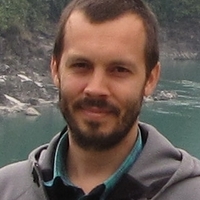Conference Presentations by Edyta Jurkiewicz-Rohrbacher
Papers by Edyta Jurkiewicz-Rohrbacher
Journal of Linguistics/Jazykovedný casopis, 2017
In the paper, we discuss the phenomenon of clitic climbing out of finite da2-complements in conte... more In the paper, we discuss the phenomenon of clitic climbing out of finite da2-complements in contemporary Serbian. Scholars’ opinions on the acceptability and occurrence of this construction, based on a handful of self-made examples, vary considerably. Expanding on the assumption that the correctness of the phenomenon has often been denied due to its rareness we employ large corpora to examine the problem. We focus on possible constraints arising from the syntactic properties of clause-embedding predicates.
Although clitics (CLs) have been very often analysed for Bosnian, Croatian and Serbian (BCS), onl... more Although clitics (CLs) have been very often analysed for Bosnian, Croatian and Serbian (BCS), only few studies approach clitic climbing (CC) in BCS. According to Čamdžić & Hudson (2002) and Aljović (2004), CC out of infinitive complements is obligatory. In the present paper, we focus on constructions with stacked infinitives and address the following research question: “Can pronominal CC appear in the context of stacked infinitives?” Based on material extracted from three web corpora {bs, hr, sr}WaC, we conclude that pronominal CC does not always occur in the case of stacked infinitives in all three languages examined. We identify the following constraints: 1. CLs in the same case but depending on two different verbs block CC. 2. Reflexivity of the infinitive embedding further infinitives seems to be involved in the blocking of CC.

Rasprave Instituta za hrvatski jezik i jezikoslovlje, 2019
In the paper, we discuss the phenomenon of clitic climbing (CC) out of infinitive complements in ... more In the paper, we discuss the phenomenon of clitic climbing (CC) out of infinitive complements in contemporary Croatian. Based on the first theoretical work and some empirical findings on CC in Czech and Bosnian, Croatian and Serbian (BCS) and the observation that differences in CC linked to register have been reported for some languages, we elaborate on the claim that CC varies in respect of both register and the Raising-Control Dichotomy. The following research questions are addressed: Does clitic climbing out of the single infinitive in Croatian depend on the type of complement-taking predicate (CTP) with respect to the Raising-Control Distinction? Does CC appear with equal frequency in standard and colloquial Croatian if the type of CTP verb (Raising vs Control) as a variable remains constant? Our study is based on data for two types of complement-taking predicates: a) Raising (8 different verbs) and b) Subject Control (8 non-reflexive + 8 reflexive verbs). The data was extracted...
Complex linguistic phenomena, such as Clitic Climbing in Bosnian, Croatian and Serbian, are often... more Complex linguistic phenomena, such as Clitic Climbing in Bosnian, Croatian and Serbian, are often described intuitively, only from the perspective of the main tendency. In this paper, we argue that web corpora currently offer the best source of empirical material for studying Clitic Climbing in BCS. They thus allow the most accurate description of this phenomenon, as less frequent constructions can be tracked only in big, well-annotated data sources. We compare the properties of web corpora for BCS with traditional sources and give examples of studies on CC based on web corpora. Furthermore, we discuss problems related to web corpora and suggest some improvements for the future.

Fuß, E. et al. (eds.) Grammar and Corpora 2016. Heidelberg: Heidelberg University Publishing (heiUP), 259-268, 2018
We have developed a machine learning approach to predict stimulation-dependent enhancer-promoter ... more We have developed a machine learning approach to predict stimulation-dependent enhancer-promoter interactions using evidence from changes in genomic protein occupancy over time. The occupancy of estrogen receptor alpha (ERα), RNA polymerase (Pol II) and histone marks H2AZ and H3K4me3 were measured over time using ChIP-Seq experiments in MCF7 cells stimulated with estrogen. A Bayesian classifier was developed which uses the correlation of temporal binding patterns at enhancers and promoters and genomic proximity as features to predict interactions. This method was trained using experimentally determined interactions from the same system and was shown to achieve much higher precision than predictions based on the genomic proximity of nearest ERα binding. We use the method to identify a genome-wide confident set of ERα target genes and their regulatory enhancers genomewide. Validation with publicly available GRO-Seq data demonstrates that our predicted targets are much more likely to show early nascent transcription than predictions based on genomic ERα binding proximity alone.

The objective of this contrastive research is (1) to determine the rules of correlation between t... more The objective of this contrastive research is (1) to determine the rules of correlation between the language-specific category Polish Verbal Aspect (PVA) and the elements of Finnish clause, whilst (2) re-examining the semantic scope of PVA, and (3) improving the definition of the cross-linguistically valid comparative concept of aspectuality. The investigation is empirical, and based on 900 Polish-Finnish clauses compiled in the form of a bidirectional parallel corpus stratified in three samples according to text types. The corpus is annotated on three levels, following the scalar model of temporality: the morphosyntactic and semantic clause-internal levels, as well as the clause-external level, including such elements as taxis and the quantificationalpragmatic context, temporally located (existentially quantified) situation, and generic or generalising interpretation (universal quantification). The reasoning in the study is mostly inductive. In contrast to the previous studies on a...
Jazykovedný časopis, 2017
In the paper, we discuss the phenomenon of clitic climbing out of finite
da2-complements in conte... more In the paper, we discuss the phenomenon of clitic climbing out of finite
da2-complements in contemporary Serbian. Scholars’ opinions on the acceptability and occurrence of this construction, based on a handful of self-made examples, vary considerably. Expanding on the assumption that the correctness of the phenomenon has often been denied due to its rareness we employ large corpora to examine the problem. We focus on possible constraints arising from the syntactic properties of clause-embedding predicates.
CMLC-5+BigNLP, 2017
Complex linguistic phenomena, such as
Clitic Climbing in Bosnian, Croatian and
Serbian, are oft... more Complex linguistic phenomena, such as
Clitic Climbing in Bosnian, Croatian and
Serbian, are often described intuitively,
only from the perspective of the main tendency.
In this paper, we argue that web
corpora currently offer the best source
of empirical material for studying Clitic
Climbing in BCS. They thus allow the
most accurate description of this phenomenon,
as less frequent constructions
can be tracked only in big, well-annotated
data sources. We compare the properties
of web corpora for BCS with traditional
sources and give examples of studies on
CC based on web corpora. Furthermore,
we discuss problems related to web corpora
and suggest some improvements for
the future.










Uploads
Conference Presentations by Edyta Jurkiewicz-Rohrbacher
Papers by Edyta Jurkiewicz-Rohrbacher
da2-complements in contemporary Serbian. Scholars’ opinions on the acceptability and occurrence of this construction, based on a handful of self-made examples, vary considerably. Expanding on the assumption that the correctness of the phenomenon has often been denied due to its rareness we employ large corpora to examine the problem. We focus on possible constraints arising from the syntactic properties of clause-embedding predicates.
Clitic Climbing in Bosnian, Croatian and
Serbian, are often described intuitively,
only from the perspective of the main tendency.
In this paper, we argue that web
corpora currently offer the best source
of empirical material for studying Clitic
Climbing in BCS. They thus allow the
most accurate description of this phenomenon,
as less frequent constructions
can be tracked only in big, well-annotated
data sources. We compare the properties
of web corpora for BCS with traditional
sources and give examples of studies on
CC based on web corpora. Furthermore,
we discuss problems related to web corpora
and suggest some improvements for
the future.
da2-complements in contemporary Serbian. Scholars’ opinions on the acceptability and occurrence of this construction, based on a handful of self-made examples, vary considerably. Expanding on the assumption that the correctness of the phenomenon has often been denied due to its rareness we employ large corpora to examine the problem. We focus on possible constraints arising from the syntactic properties of clause-embedding predicates.
Clitic Climbing in Bosnian, Croatian and
Serbian, are often described intuitively,
only from the perspective of the main tendency.
In this paper, we argue that web
corpora currently offer the best source
of empirical material for studying Clitic
Climbing in BCS. They thus allow the
most accurate description of this phenomenon,
as less frequent constructions
can be tracked only in big, well-annotated
data sources. We compare the properties
of web corpora for BCS with traditional
sources and give examples of studies on
CC based on web corpora. Furthermore,
we discuss problems related to web corpora
and suggest some improvements for
the future.